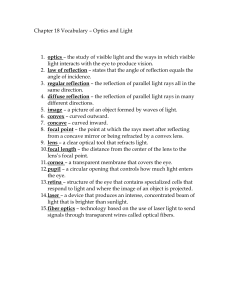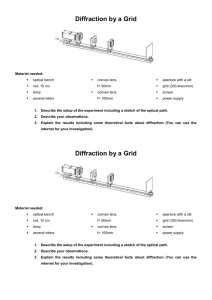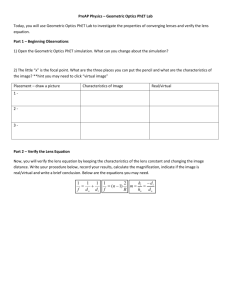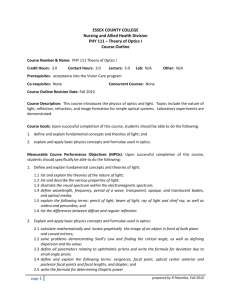Intro Optics Presentation - Workspace
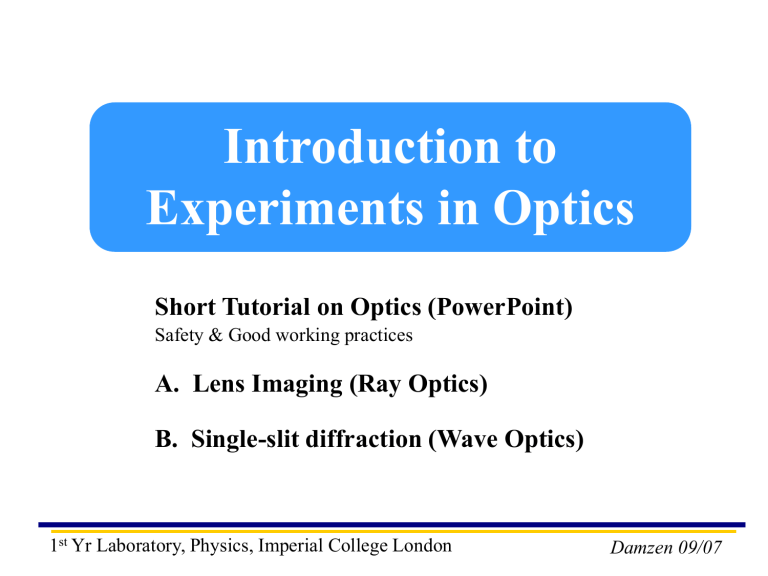
Introduction to
Experiments in Optics
Short Tutorial on Optics (PowerPoint)
Safety & Good working practices
A. Lens Imaging (Ray Optics)
B. Single-slit diffraction (Wave Optics)
1 st Yr Laboratory, Physics, Imperial College London Damzen 09/07
Technological Revolution in Optics
Communication by photons
METRO
WAN
TRANS-
OCEANIC
V
Telephony/data/internet
WAN
METRO
Massive optical data storage
CD/DVD Blu-ray disc (25GB)
Precision laser machining
Laser cutting
Laser writing on human hair Photolithography for manufacture of computer chips
Medical laser therapy
& optical imaging
Corrective laser eye surgery 3-D laser imaging of cell
Optics has an important place in history
Optics, light & vision has been vital for human survival
Telescope observations forged our understanding of the Universe
Microscopes revealed a microuniverse
Today, Optics remains a key scientific diagnostic technique (e.g. imaging).
A new revolution in
Optics has emerged with the birth of the laser, fibre optics, integration of optics and electronics, etc..
Historical debate on nature of light
Particles or Waves
Light = EM waves c
1
0
0
What is Light? - Revisited
LASER
Wave-particle duality
Quantum Optics
Lasers
Stimulated emission
Paradoxes in physics (BB radiation/ photoelectric effect)
Quantisation of light (photons) E=h n
Bohr model of atom
Wavefunctions / Probability
Diffraction of electrons
Planck / Einstein
Michelson
Maiman (Laser)
…
Fundamentals of Optics
REFLECTION
Mirror
REFRACTION
Refractive index boundary
r
i
r
=
i
DIFFRACTION
Aperture
1 n
1 n
2
Snell’s Law n
1 sin
1
=n
2 sin
2
2
INTERFERENCE
IMAGING h o
O F
1
s
1 s
1 f s
Imaging Lens
F’ f s’ m
s
s
I h
I
POLARISATION
Linear polarised Elliptically polarised b a
beam spread double-slits screen
Continuum of waves Finite no. of waves
E
E
0
cos(
sin(
)
)
cos(
t ) E
E
0
2
cos( cos(
t
t )
/ 4 )
EM-theory
Safety and Lab-book Practices
Safety
•
Laser Safety
NEVER LOOK DIRECTLY INTO THE LASER OR POINT LASER AT OTHER PERSONS
• Electrical Safety
• Trip Hazards
Your Laboratory Notebook
DATE, TIME, TITLE OF EXPERIMENT.
CLEAR WRITTEN RECORD AS YOU GO ALONG.
DESCRIBE & DRAW WHAT YOU ACTUALLY SEE.
Lenses –Ray Diagrams and Formulae
CONSTRUCTING RAY DIAGRAMS
O F
F’ I s s’ f
O object; I image s object distance; s’ image distance; f focal length
PRINCIPLE RAYS : ( Any 2 are sufficient to construct image )
•Ray passing through the centre of the lens is undeviated.
•Ray parallel to the optical axis passes through a focal point.
•Ray passing towards, or away from, a focal point emerges parallel to the axis.
LENS
CALCULATIONS
Thin lens formula
1 s
s
1
f
1
Magnification m formula
s
s
In later lab-work: you’ll explore issues of real lens (e.g. finite aperture; lens aberration)
Before we proceed to first experiment…..
•
Find a lab-partner & Sit at one of the Optical Set-ups
1. Open your lab-book and write date and time
2. Write heading “ Introduction to Experiments in Optics ”
3. Write sub-heading: “ A. Thin Lens Imaging ”
Aligning an Optical Bench
A good rule of optical alignment is to:
• place one item at a time on bench (starting at light source)
• ensure light propagates parallel to bench (rotate post of light source if necessary)
• optical components are centred (by adjusting post height) and
• optical components are at right-angles to beam path (by rotating post).
object
Light source s
Optical rail lens image, observed on ground-glass screen s’
Observe from behind ground-glass screen
Expt 1.1 Imaging with a Lens
1. Switch on light source (supply at ~ 5V preset, do not adjust)
2. As object place slide
3. Place f=100mm lens at object distance s=150mm .
Measure s with ruler from object to lens centre of letter
L
, in slotholder on light source
Object, L f=100mm
4. Adjust position of ground-glass screen for sharpest image.
ground-glass screen
Measure s’
.
Light source s~150mm s’
Observe from behind ground-glass screen h
O
Optical rail
5. Measure a dimension of object ( h
O
) and corresponding size in image ( h
I
).
Deduce magnification
|m|=h
I
/h
O h
I
• Estimate an error for all experimental values measured s, s’, h
O
, h
I
.
Errors?
s
4 measured h
O quantities
h
O
O h
I
s
h
I s s
I
s s
|
Experimental measurement m |
h h
I
O m
m
m
|
Theoretical prediction m |
s s
m
m
m
Why is
s’
>
s
?
How might you estimate
s’
?
equation of form : z
x y z
x y
z
z .
x x
2
y y
2
Calculate the magnification (inc. standard error) for the two methods.
Do they agree / are they consistent given the errors?
Experiment 1.2 Measuring focal length of lens
1. Use pin-hole slide as object f=100mm
2. Angle mirror so you can see reflected spot of light on object slide.
(You may not be able to see this until lens is near its focal length position) mirror
Pin-hole object
Light source f
Figure 3: Simple method for estimating focal length of a positive lens.
3. Measure focal length f by finding the position for minimum reflected spot size
Is focal length f=100mm?
z
B. Wave-Optics : Single-slit Diffraction
secondary wavelets
Aperture (width a) causes light to spread
(diffraction) a
Light pattern at any plane z is the sum of secondary wavelets of the unobstructed aperture (including phases) z
Far-field (z>>a 2 / l
)=
Fraunhofer diffraction
(simpler mathematical form
=Fourier Transform)
Near-field (z<a 2 / l
) =
Fresnel diffraction
(complex mathematical form)
Far-field at focal plane of lens
Problem: Far-field z>> a 2 / l may not be convenient for lab bench.
Solution: Use lens.
a) input light diffracted rays at angle
meet at infinity
~ x b) parallel rays meet at a point in focal plane
f
Lens, f observing screen diffracting object
L very distant observing screen
Figure 4: The far-field diffracted pattern can be visualised in the focal plane of a lens.
f x x
Expt.2 Visual Observation of Single-Slit
Diffraction Pattern
bi-convex lens f=1000mm observation screen
‘white card’ x
DIODE
LASER f
Diffracting object = variable slit
1. Replace white light source by
Diode Laser
2. Visually observe diffraction pattern of variable slit on white screen placed at focal length of lens
•
Note in you lab-book the effect of changing the slit width .
•
With the central maximum peak of width ~10mm sketch the diffraction pattern (to scale)
Far-field Single-Slit Diffraction Pattern
I ( x ) I
0
sin
l
l ax f ax f
2
Is this what you see?
f x
1.0
0.8
0.6
0.4
0.2
0.0
-10 -5 0
Distance x
5
Positions of zeroes x m m
= m( l f/a)
1 ,
2 ,
3 ....
10
Logarithmic Response of the Eye
1.0
0.8
0.6
0.4
0.2
0.0
-10 -5 0
Distance
5 10
1
0.1
0.01
-10 -5 0
Distance
5 10
Measurement with a Photo-detector
LASER bi-convex lens f=500mm
Photodiode/slit assembly on translation stage
1. Switch on photodiode power supply and set voltmeter to 200mV setting f diffracting object = single slit slide
2. Position central maximum of diffraction pattern to coincide with photodiode slit at centre of its translation stage. You may need to rotate laser and move diffracting slit sideways to achieve this voltmeter
I
1
X
-1
I
0
X
1
l f/a
l f/a
Measurements:
1.
Measure voltage of central maximum (V
0
) and first secondary maximum (V
1
).
2.
Measure positions of the first minima (X
1 using:
X
1
– X
-1
= 2 l f/a and X
-1
). Hence calculate the slit width
Final Comments
It is hoped that this introductory Optics session has given you:
• some useful practice in laboratory work (inc. lab notebook and errors)
• provided some groundwork for more advanced Optics you will perform in the lab later in the year.
• confidence in working in the UG laboratory


